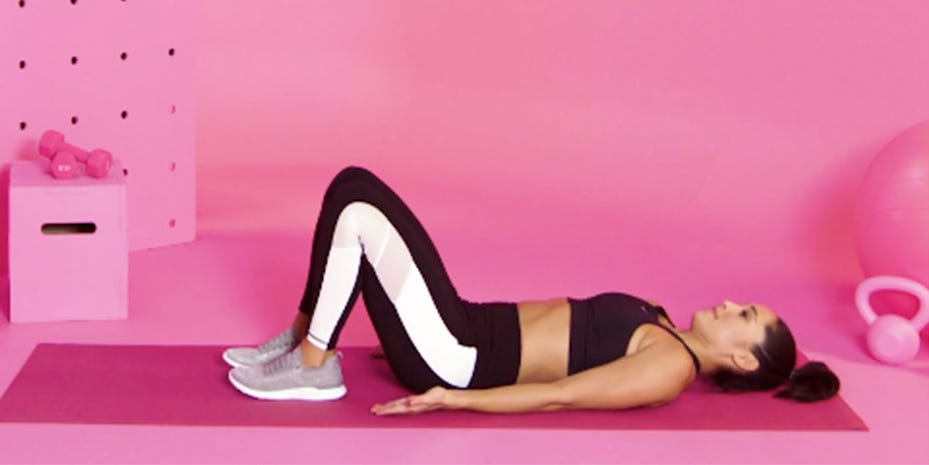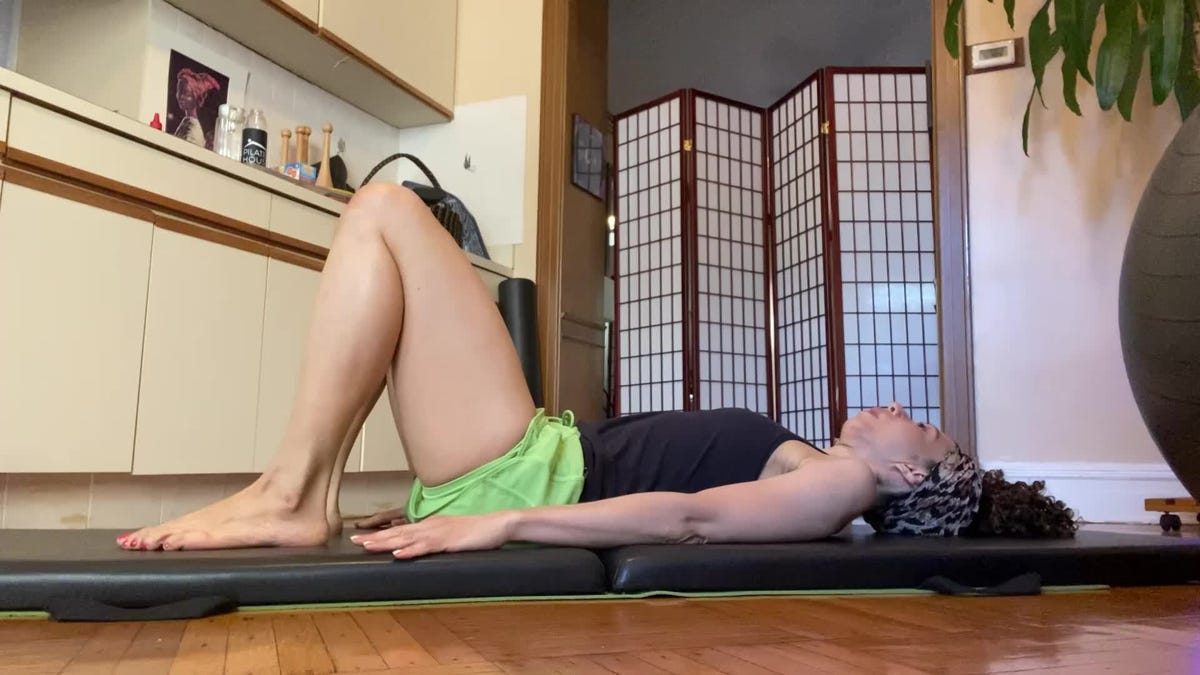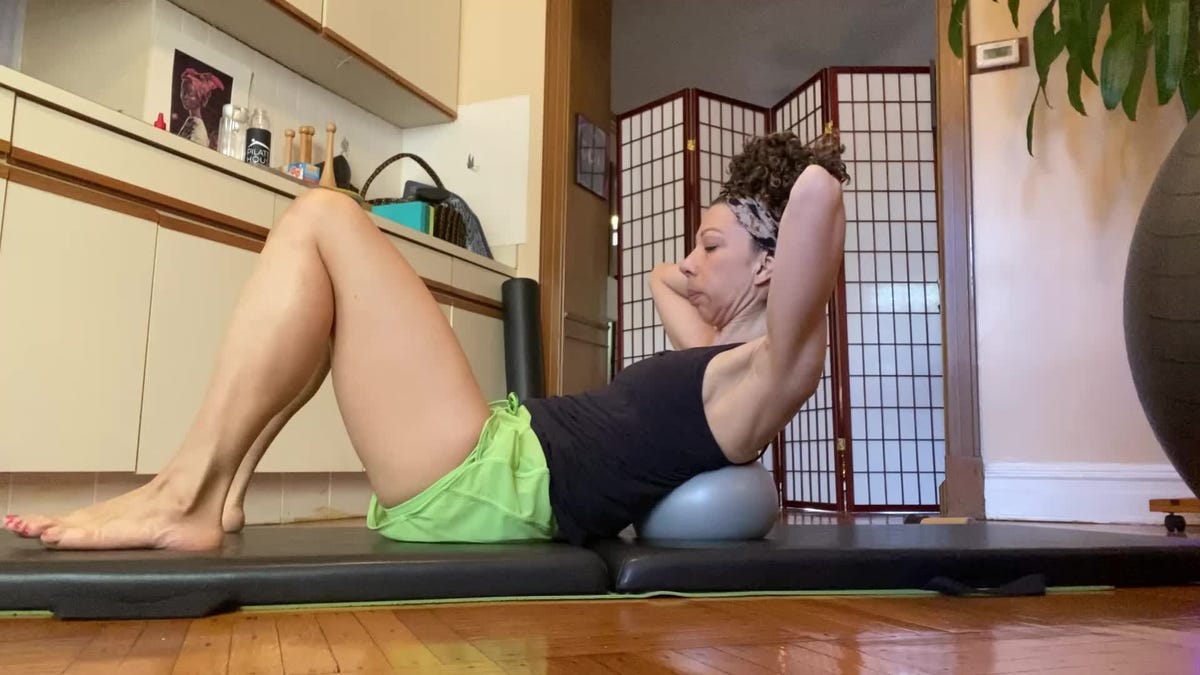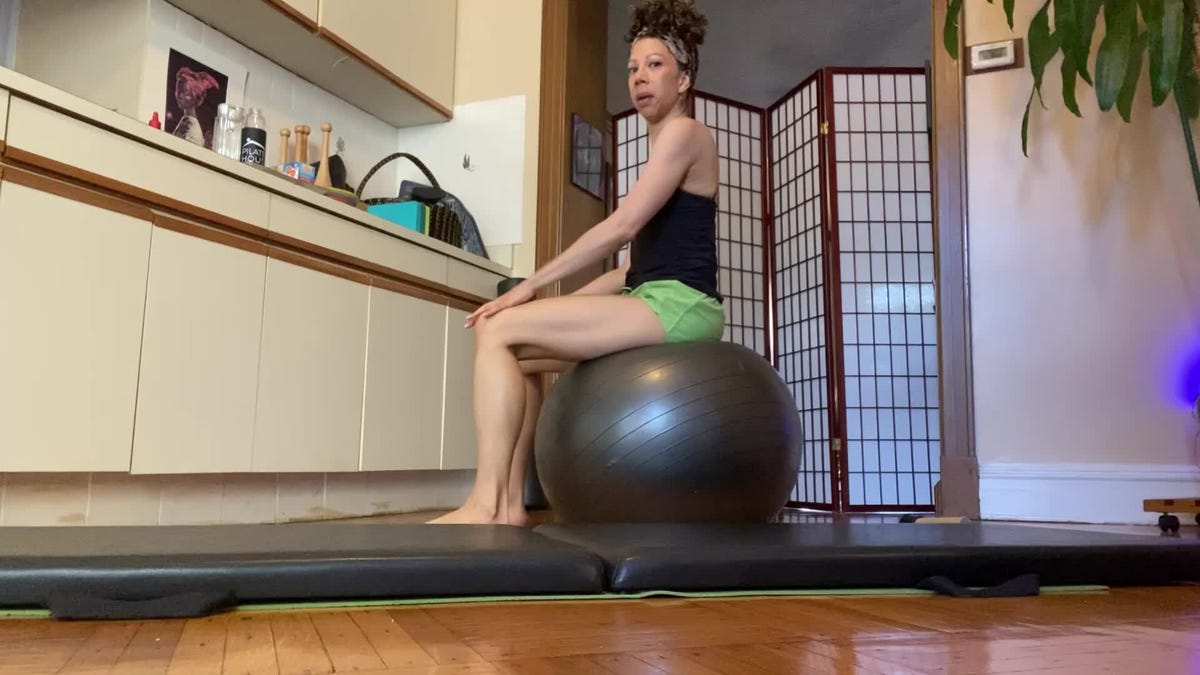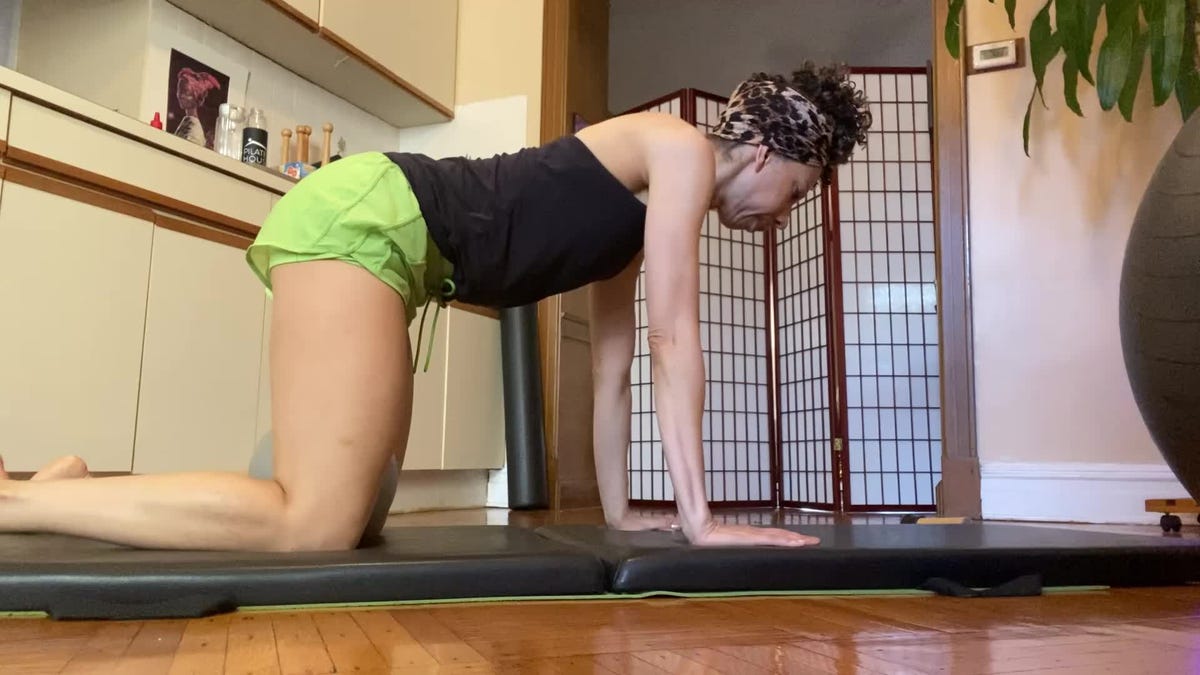Your pelvis is your body’s unsung hero. That bowl-shaped configuration of bones in your lower abdomen is the main support for your spine and connects to the glutes, quads, core, and pelvic floor, so it’s important not to neglect it. Cue pelvic tilts!
In pilates, pelvic tilts are a common and fundamental movement involving the positioning of the pelvis in relation to the spine, says Diarra Cummings, a certified pilates instructor and founder of Snatched Fitness NYC. “Pelvic tilt exercises often involve a rocking or swinging action of the pelvis while stabilizing the legs and spine,” she says. But, they’re also a small, subtle movement, so proper form is key to reap all the (major!) benefits.
Meet the experts: Diarra Cummings is a pilates instructor, with additional certifications in pre/post-natal pilates, and founder of Snatched Fitness NYC. Jackie Sherwood, ACE-CPT, is a pilates instructor and former Joffrey Ballet company member. Lexi Burtman, DPT, is a pelvic floor physical therapist at Solstice Physiotherapy, mat pilates instructor, and co-founder of Elevated Pelvic Products. Emily Claman, CPT, is a prenatal and postnatal fitness specialist and founder and CEO of Push.
Benefits Of Pelvic Tilts
This is not an exercise that you’re going to be sore from, but it will help you sustain healthy joints and good mobility, says Cummings.
Pelvic tilts help keep your pelvis neutral, easing stress and pain in your back and hips. That’s important since a lot of people tilt their pelvis too far forward (anteriorly) or backward (posteriorly), which can mess with posture and cause discomfort, says Emily Claman, CPT, a prenatal and postnatal fitness specialist and founder and CEO of Push.
These exercises also fire up your lower abdominals and deep core muscles. “Your deep core consists of your transverse abdominis, multifidus, diaphragm, and pelvic floor muscles, and since we can’t see these muscles, they can be harder to engage and relax,” she says.
Speaking of the pelvic floor, training it may enhance sexual function and lead to stronger, more pleasurable orgasms, according to a study in the American Journal of Obstetrics and Gynecology. “Pelvic tilts can contract and relax the pelvic floor muscles,” says Burtman, which helps strengthen them as well as increase blood flow to the area.
How To Do Pelvic Tilts
Remember: Pelvic tilts are a subtle, barely visible movement that teach control and fire up the deep muscles of the core. Try incorporating the move first thing in the morning to help loosen your lower back, or as a warmup or cooldown during your workout routine.
Time: 10 minutes | Equipment: mat, yoga block (optional), stability ball (optional), pilates ball (optional) | Good for: pelvic floor, core
Instructions: Complete two sets of 10 reps, three to five days a week.
How to:
- Lie on your back with knees bent, legs hip-width apart, and soles of your feet flat on the floor.
- Keep your arms relaxed by your sides and a natural curve in the lower spine (there should be a slight space between your lower back and the floor).
- Inhale, and on the exhale, gently shift your weight into the back-center of your pelvis so your tailbone curves upward, feeling your lower abs engage and sink inward as the lower back flattens. (The gap between your lower back and the floor should close.)
- Keep your lower back on the mat and hold for 5 seconds.
- Inhale and fully release the tilt, allowing your pelvis to return to starting position. That’s 1 rep.
Pro tip: Cummings recommends squeezing a yoga block or pilates ball between the inner thighs to fire up the inner thigh muscles, stabilize the lower body, and maintain correct alignment.
Common Pelvic Tilt Mistakes To Avoid
Gripping the hip flexors: Instead of tensing your hip flexors and initiating pelvic tilts with the quads, push down into the feet to engage the hamstrings and inner thighs, says Cummings. After shifting into the tilt, think of softening or releasing tension in the hip flexors, says Jackie Sherwood, ACE-CPT, a pilates instructor and former Joffrey Ballet company member.
Compressing the lower back: “Pelvic tilts are never about creating compression in the spine,” says Sherwood. Instead, practice visualizing space between each vertebra and breathing deeply to promote a feeling of expansiveness throughout the movement, she says.
Holding tension in the upper body: Pelvic tilts are all about smooth control, so holding tension in your neck and/or shoulders, which is common for those dealing with lower back tightness, is counterintuitive to the potential benefits. Sherwood recommends thinking about melting the ribcage and back of the head onto the mat. You can also focus on maintaining a wide, expansive posture across the chest and anchoring the shoulder blades to the ground, says Cummings.
Allowing the glutes to overpower the abs: Pelvic tilts are not hip bridges. In fact, they’re not a glute-focused exercise at all, says Sherwood. If you find yourself clenching your glutes during the pelvic tilt, pause, reset, and think about only moving “the bones,” she says. “Shift the back-center of the pelvis toward the mat, and the targeted muscles will organically correct.”
Pushing the abs outward: Yes, you should feel your core engage, but you should not push your abs or belly outward, says Cummings. “Pull the waist inward and hollow the abdominal wall before moving the pelvis into the tilt,” she says.
Pro tip: You might already be doing pelvic tilts (especially if you do yoga or pilates). A lot of core work such as bicycle crunches, forearm planks, and bear planks, require a slight pelvic tilt, says Sherwood.
Pelvic Tilt Variations For All Levels
Press play on each video to follow along with Cummings for her form modifications:
Modify your upper body support.
- Instead of lying flat on your back, prop yourself up using a pilates ball (or your forearms). This gives you a clear view of the pelvis and tilt.
- Move the pelvis forward and back as you normally would with the same step-by-step instructions as above.
- Watch the pelvic movement to help practice control and gain awareness in the subtle motion.
Sit on a stability ball for more challenge.
- Sit tall on a stability ball, with feet flat on the floor and hip-width apart.
- Tilt the pelvis so the pubic bone rolls upward and the tailbone rolls forward.
- The ball will slightly shift underneath you, but this positioning will increase difficulty and work on stabilizing your core.
Come onto all fours.
- Come onto hands and knees in a tabletop position (quadruped).
- Inhale, then point your tailbone toward the ceiling.
- Hold for 5 seconds, then exhale and point your tailbone toward the ground.
Who can do pelvic tilts?
The beauty of this simple move is pretty much everyone can enjoy the perks. Pelvic tilts really shine during and after pregnancy (more on that soon!).
There are a few folks who should steer clear, though. “Anyone with a recent [or] chronic lower-back injury, severe osteoporosis, recent surgery, or a diagnosis of a posterior spinal herniation should avoid the pelvic tilt until consulting with their doctor,” says Sherwood. If you experience pain while performing the move, check-in with your physician or physical therapist.
How To Do Pelvic Tilts During Pregnancy
Quick disclaimer: Always talk to your healthcare provider if you’re pregnant and looking to try any new form of exercise. That said, pelvic tilts can be a great part of a prenatal exercise routine as the weight of a baby loads the spine and commonly causes lower back tightness, per Sherwood and Cummings. If lying on your back is uncomfortable during pregnancy, try doing pelvic tilts on a stability ball or come onto all fours (quadruped).
The subtle move is helpful for maintaining mobility at the pelvis during pregnancy, says Burtman. “Throughout pregnancy, we want to make sure you’re able to tilt your pelvis back (under) to keep your center of gravity from going too far forward and your back from arching too much, because the inability to tilt or move your pelvis can be a major cause of back pain with a growing belly,” she says. Maintaining mobility throughout pregnancy also increases blood flow to the pelvic floor muscles which work extra hard to support the growing uterus and baby, she says.
Your baby also needs to drop lower into the pelvis during labor, and maintaining pelvic mobility can help baby move lower, quicker, says Burtman. And when it comes to the actual delivery (if you deliver vaginally), pelvic tilts can help you to better relax the pelvic floor, engage your deep core, and increase blood flow to support a smooth exit, she says.
For postnatal recovery, pelvic tilts can help you to regain connection to the deep intrinsic pelvic stabilizers and condition the transverse abdominis (the deepest layer of abdominal muscles). “Pelvic tilts are also a calming exercise and can be helpful in regaining a sense of center amid the flurry of motherhood, ” says Sherwood.
All that said, listen to your body and decrease the range of motion of your pelvic tilt when needed, says Burtman. Only go as far as you can without discomfort.
Andi Breitowich is a Chicago-based writer and graduate student at Northwestern Medill. She’s a mass consumer of social media and cares about women’s rights, holistic wellness, and non-stigmatizing reproductive care. As a former collegiate pole vaulter, she has a love for all things fitness and is currently obsessed with Peloton Tread workouts and hot yoga.
Talene Appleton is the fitness editor at Women’s Health, where she covers all things fitness, nutrition, and healthy living. She studied nutrition and exercise science at George Washington University and is a NASM-certified personal trainer and nutritional consultant. Passionate about the intersections between fitness, food, and community, she strives to foster inclusive and holistic wellness narratives for underrepresented populations. When not writing, she can be found hosting dinner parties and exploring new wellness and culinary experiences around New York and Los Angeles. Prior to her role at Women’s Health, she was the fitness and commerce editor at Men’s Health and contributed to General Surgery News, The Food Institute, and The Nessie.
Read the full article here


